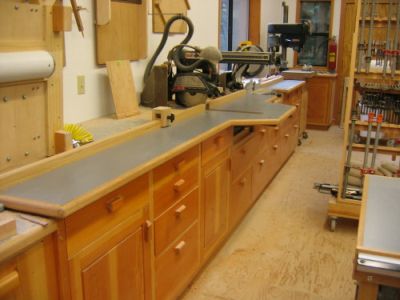I know this is a Solid Wood forum, but it seemed the best category. My shop is looking to use an old Weinig U22N moulder to mill engineered flooring with our side match profile and width/thickness tolerance. My concerns are mostly focused around the tolerance expectancy.
This product has a veneer about 0.125" with an adhesive and plywood composed layered construction the remaining thickness to bring us to 0.600"
- This molder does not have opposing side heads, what can I do to help keep the tightest tolerance/minimal snipe possible, and what is a safe expected tolerance?
- Can I use the same tooling that I normally use to mill solid wood with? Is my assumption that my tool life is going to be dramatically shortened correct?
- This molder has always seemed to have a problem keeping the thickness of parts within an acceptable tolerance. It can easily run 0.010" -/+. What should I be looking at to correct this assuming the shoe and tooling are positioned correctly?
This is a bit different for us, as we normally run two Hydromat 22's just a few years old to make solid flooring, and this machine has only been used to make occasional parts for the past several years, and was manufactured in 1978.
From contributor rt
Plus or minus .010" is pretty darn good for a 1978 machine. I would venture to guess you won't do much better if it has seen a lot of use, meaning wore bed plates, fences, chip breakers etc. As for tooling, high speed steel will wear immediately at the glue lines which will repeat at the exact same spot on every piece. I would be looking at some quality insert heads and try different grades of carbide.
From contributor Ru
Rt brings ups some very good points about wear on machine, I would second the same opinion about getting carbide inserts for the side heads.
If we can be of any help, all contact information on our website.
Good luck
From contributor sh
I would really go with a solid carbid insert head you will get really good life from a insert and your. Tolerances are better.
From contributor Ch
Thanks for all the responses. We currently do use solid carbide inserts to mill our solid, and would have our tooling company make up new profiles for this project.
After talking to Weinig they advised against trying to retro fit the machine with opposing heads, and without them we wouldn't get the footage and quality we are looking for. Now the question is whether or not we want to purchase a new machine, and what kind we would get.
Has anyone hear used a leadermac? How are they compared to a Weinig moulder?
From contributor re
i run a leadermac 5 head . bought it new in 2009, have ran over 500,000 sq.ft. of flooring and vgroove no issues at all. at that time the machine was half price of the weinig profamat.
i use to run weinig but, they priced them self out of contention.
if you have 2 newer moulders why buy another machine ? run it on one of those.
From contributor Dr
Chris
Flooring is just another moulding profile with a few possible issues. The most common is pistol gripping, this is where the end of the wood "bends" and the flooring leaves a gap. I have setup well over a hundred older Weinig's to run flooring.
A few things to make sure about your machine:
-the fences must be perfectly straight and square to the frame of the machine
-the table wear must be removed
-the top and bottom dovetails must be clean and properly adjusted to the frame of the machine
-the pressure shoe must be aligned
-the feed roller pendulums need to be working correctly
-the table rollers need to be set properly
-all chipbreaker springs need to function properly
-spindle bearings must be good
-I recommend carbide insert tools for the side heads
Be Safe,
Dr. David Rankin
From contributor Ja
Chris, if your looking into leadermac make sure you compare to Kentwood.
